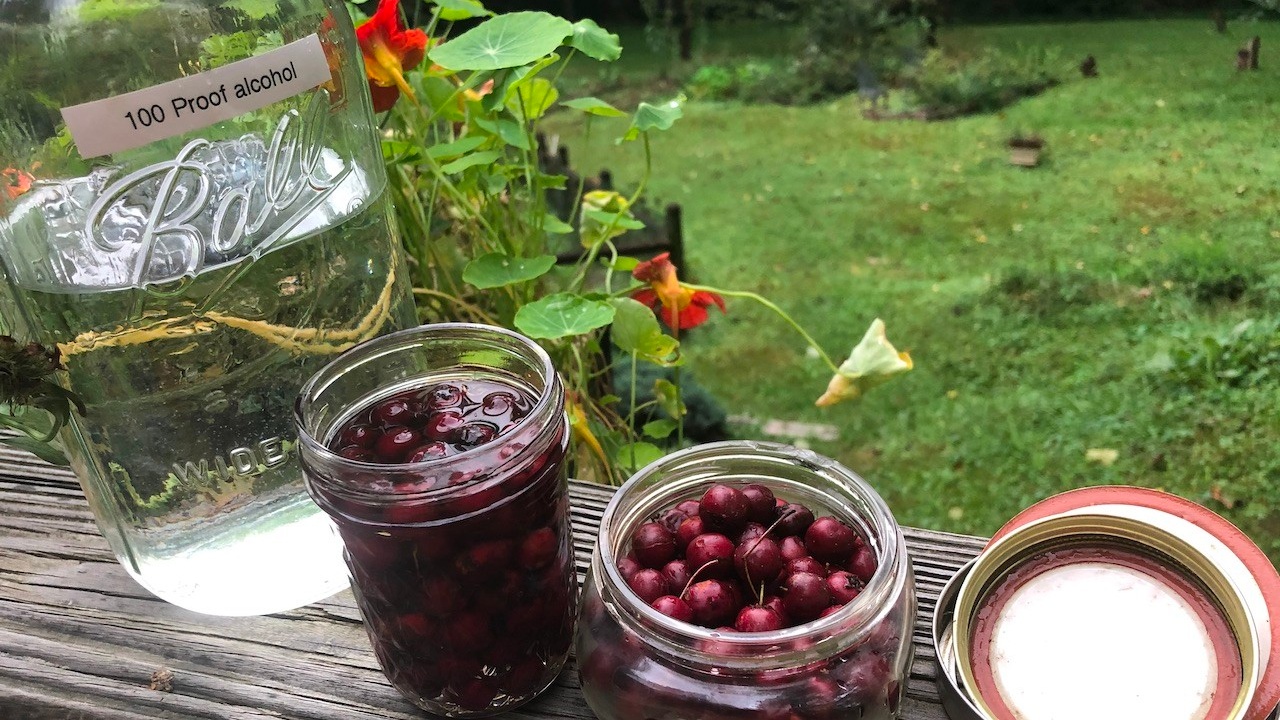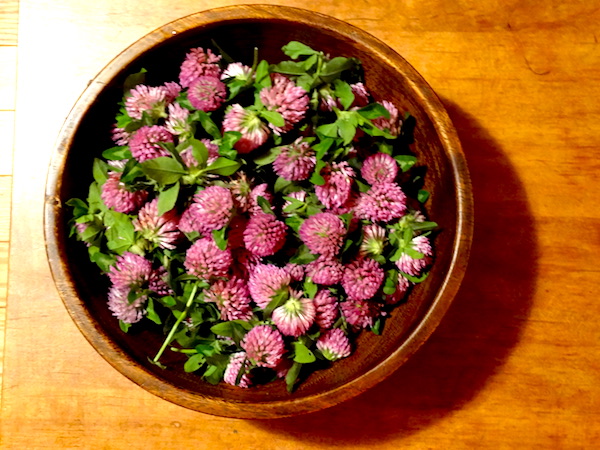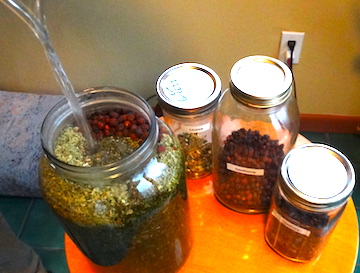How to make an herbal tincture and herbal infusion—the easy and potent way

by Corinna Wood
Has it happened to you too?
You may find yourself scratching your head about when and how to make an herbal tincture or infusion...
When I was in college, I rode my bike by expansive fields of red clover every day on my way to and from school. I felt called by the lovely flowering herb but didn’t know what to do. Could I eat red clover? Make tea? Or tincture? It turns out with red clover, I could do all three, and I did.
Today, infusions and tinctures are my favorite ways to receive the health benefits of the medicinal herbs (besides eating them as wild foods, of course).
Infusions are a daily drink in my kitchen—a water-based preparation that extracts many nutritive properties, and lasts just a few days in the fridge.
Tinctures are a medicine chest staple, as handy alcohol-based preparations that preserve medicinal constituents of herbs for years.
Shall I explain?
Table of contents
- The Wise Woman approach
- Making an herbal infusion (water-based)
- Making an herbal tincture (alcohol-based)
- Solving the mystery
The Wise Woman approach
 In wise woman herbal medicine, we first turn to common abundant herbs—often considered “weeds”—for our medicines.
In wise woman herbal medicine, we first turn to common abundant herbs—often considered “weeds”—for our medicines.
Is red clover growing abundantly around you?
Don’t overlook this gem, known as the “queen of the blood purifiers.”
Or who else is abundant at your doorstep . . . maybe dandelion, chickweed, or violet?
We live in the same ecosystem as the plants around us—the same soil, air and water. As they thrive in that environment, they support our thriving as well.
Using the folk medicine techniques described below, making medicine is also very easy! Choosing the method of preparation is often determined by the medicinal use you intend—that is, the type of constituents you’re going for.
As you know, it's essential to positively identify any plants you're harvesting for food or medicine. First things first: Grab my free guide on 3 Poisonous Plants to Watch Out For (pdf) so you can stay safe on your herbal adventures.
How to make an herbal infusion (water-based)
Infusions are a wonderful way to nourish and tonify your body on a daily basis.
If you want to extract nutrient-rich constituents like vitamins, minerals and chlorophyll, water-based infusions from dried herbs are the way to go.
While you’ll get some medicinal benefits from using a tea bag, you’ll receive manyfold the nutrients and medicinal constituents from preparing dried herbs as an infusion—essentially a strong medicinal tea.
Making a nourishing herbal infusion
- Place one ounce (about a cup) of dried herb into a quart mason jar
- Fill with boiling water, cap it, this traps in all the volatile oils
- Let steep for 4-10 hours
- If you like, you may add a pinch of mint for flavor
- Then strain out the plant material, compost it, and enjoy one or more cups of the liquid daily
- Refrigerate the remainder to prevent spoilage
 Infusions keep for several days in the refrigerator. A standard dose of infusion is a pint a day, although I often find myself enjoying twice that! You can drink it warm or cold, sweetened with honey, or flavored with mint…
Infusions keep for several days in the refrigerator. A standard dose of infusion is a pint a day, although I often find myself enjoying twice that! You can drink it warm or cold, sweetened with honey, or flavored with mint…
Infusions are best made with dried herbs. While I always prefer to make tinctures from fresh herbs, the tinctures have 6 weeks to extract the plant constituents into solution (more on that below).
Infusions will spoil, like food, within a few days.
So why dried herbs? The catch is that the cell walls of plants are very thick and difficult to penetrate. During the drying process, the cell walls of the plants break down to release the water. Later when the dried herbs are submerged in water, those constituents will become available.
So if you have fresh plants—say, stinging nettle—and you prepare the fresh herb as an infusion, the water will just turn light brownish-green, whereas the infusion from dried nettle is a deep emerald color.
If you have fresh nettles, by all means, cook them and eat them! (Don’t worry, they lose their sting after 10 minutes of cooking.) When you make stinging nettle soup, you’ll receive the benefits of both the broth and the plant material.
My favorite herbs for infusions
My favorite infusion herb is nettles, which is nourishing for the adrenals and kidneys as well as the hormonal and immune systems. Drinking nettles over time supports sustained energy levels. When we drink nettles we’re nourishing our adrenals instead of stimulating the adrenals, as caffeine does, which can lead to adrenal exhaustion.
My next favorite infusion herb is Oatstraw. This is actually the straw of the oat grass, which is nourishing for the nervous systems and supports sleep.
How to make an herbal tincture (alcohol-based)
When you are looking for a fast-acting herbal extract, appropriate for many first-aid situations and acute ailments, tinctures are the way to go. They are handy, quick, and long long-lasting, from 3-5 years or more.
To understand why let’s take a quick look at the chemistry behind tinctures.
The specific medicinal properties of plants are often contained in alkaloids.
While one could extract plants into various menstruum (water, vinegar, oil, etc), alcohol is the strongest menstruum for extracting alkaloids, so it is the ideal base for most herbal medicines.
In order to extract properties that are soluble in both water and alcohol, I use 100 proof alcohol.
Alcohol proof is defined as being double the amount of alcohol by volume. 100-proof alcohol is 50% water and 50% alcohol. This allows us to extract properties that are soluble both in alcohol and in water.

Wondering just how to make an herbal tincture, and what plant material to start with?
While you can make tinctures from dried herbs, I always prefer to make tinctures from fresh plants.
Making our own medicine is a powerful act in itself, and the tinctures we make are usually even more potent than those we might buy from a large herbal company.
As the old adage goes, the quality of the medicine depends on the quality of the plant material—and the quality of the plant material depends on how close it is to the source.
That means tinctures made from fresh herbs you picked from your yard this morning are actually made from higher-quality plant material than a big company that gets dried herbs shipped in from all over the world.
So when you dig up dandelion roots in your backyard this fall, wash them, chop them and put them directly into a jar, and cover them with 100 proof alcohol. That’s as close to the source as it gets!
How to make herbal tincture at home
To learn how to make herbal tincture at home from fresh local plants, just follow these six easy steps:
- Fill a jar to the top with fresh plant material, packed tight
- Fill the jar to the top again, with 100-proof vodka, and cap
- Label the jar—for example, Yarrow blossom, 100 pf vodka, 6/30/2021
- Top off the liquid level the next day
- Leave your tincture brewing on your counter for six weeks
- Strain out the plant material

That way you don’t need to bother with weighing or measuring.
However, If you must, to measure the amount of plant material, you are going for about a 1:2 ratio of the weight of the plant to the volume of the alcohol. So if you have 6 ounces of dandelion roots, you will use about 12 fluid ounces of alcohol.
When making your own tinctures, it’s best to brew them for 6 weeks to allow the constituents to extract into the alcohol. Again, this will make more potent medicine because the industry standard for large herbal companies is to brew for only 2 weeks. At the end of your brewing time, strain out the plant material and pour your tincture into a dropper bottle.
My favorite herbs for making tinctures
Some of my favorite tinctures to have on hand for herbal first aid in the family medicine chest include:
- Echinacea
- St Johnswort (aka St Joanswort)
- Wormwood
- Motherwort
Other popular tinctures include these long term tonics:
- Vitex berry for menopausal support
- Dandelion root for supporting the liver
- Hawthorn berry to nourish the heart and circulatory system
If you're concerned about consuming alcohol you can put your tincture into a cup of warm tea when you take it. Alcohol has a lower boiling point than boiling water so it is released in the steam. (However, note that the amount of alcohol is minimal—a "dropperful" has about as much alcohol as a ripe banana.)
When taking tinctures it's best to dilute in water or juice. One “dropperful” equals about 25-30 drops (when you squeeze the rubber bulb, the dropper fills about halfway up).
Solving the mystery of how to make an herbal tincture or infusion
 Using these simple folk method techniques, making medicines the wise woman way is easy and fun!
Using these simple folk method techniques, making medicines the wise woman way is easy and fun!
The knowledge of how to make an herbal tincture or infusion is now yours to incorporate into your day-to-day life.
Just remember, when deciding which method to use, consider what constituents you want to extract and what use you have in mind.
For drawing out nutrients and minerals, infusions are the way to go.
For fast-acting medicinals to stock your medicine cabinet, alcohol-based tinctures are first choice.
I encourage you to take a look around outside—in your yard, garden, or along the paths you walk—to see which common abundant herbs are making themselves known to you, ready to support your thriving.
________
Spread the wise woman ways! Link to this article from your website or share with your friends using this button~
Comments ~ what stands out for you today?







